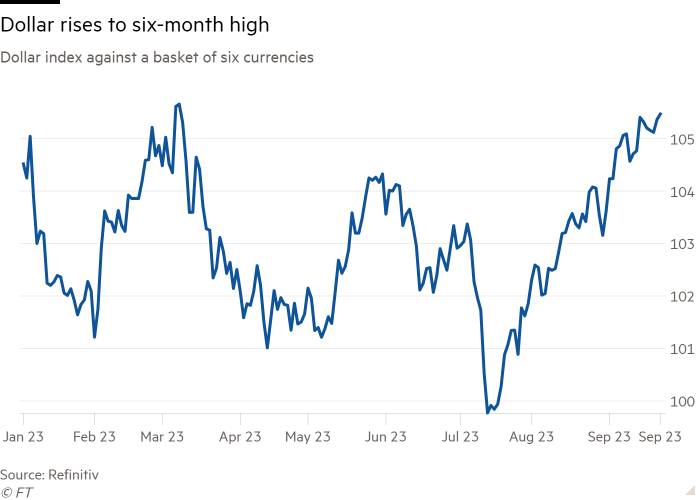Obtain free Currencies updates
We’ll ship you a myFT Every day Digest e-mail rounding up the most recent Currencies information each morning.
The greenback climbed to a six-month excessive on Friday on the finish of every week when US inventory and bond markets weakened and traders ready for a protracted interval of excessive rates of interest.
The foreign money hit its highest ranges in opposition to the euro, the pound and the yen since no less than March after the Federal Reserve set out plans to chop interest rates — now at a 22-year excessive — far more slowly than economists had thought.
US authorities bond costs fell, sending yields to their highest ranges in 16 years, whereas the S&P 500 benchmark index of blue-chip US shares suffered certainly one of its deepest weekly declines of the yr.
“Markets have taken the Federal Reserve fairly negatively,” mentioned James Briggs, a portfolio supervisor at Janus Henderson Buyers. “Higher for longer is clearly entrenched and the conviction is that we’re in a brand new regime.”
The Fed’s determination to maintain charges on maintain this week and to sign its resolve to cut back them solely slowly all through subsequent yr and in 2025 was adopted by the Bank of England, which additionally burdened the significance of sustaining excessive charges.
The European Central Bank raised its personal benchmark charges to an all-time excessive this month.
Current slides in US and eurozone bond costs come after months of sell-offs in international fixed-income markets, largely due to greater benchmark rates of interest and higher inflation.
Some market contributors warn the chilling impact of an prolonged interval of excessive rates of interest additionally makes fairness markets extra fragile, due to the influence of upper borrowing prices on the broader economic system.
“It’s an unstable state of affairs,” mentioned Joseph Davis, international chief economist at Vanguard, who argued inflation has traditionally often been vanquished at the price of decrease development. “There have been hardly any examples ever of inflation coming down with hardly any trade-offs,” he mentioned.
Indicators the US is proving extra resilient than different main economies have helped the greenback climb 6 per cent in opposition to a basket of different currencies since mid-July.

Jobless claims fell to their lowest stage since January this week whereas purposes for unemployment help fell near an eight-month low.
“I feel the US is in a number one spot,” mentioned Robert Tipp, head of world bonds for PGIM mounted earnings. He argued the markets had been lastly being satisfied that the Fed would maintain rates of interest excessive — partly as a result of the nation’s financial prospects are higher than elsewhere.
In its efforts to tame inflation that topped 9 per cent final yr, the Fed has elevated charges 5.25 share factors over 18 months — one of the aggressive financial tightening cycles in its latest historical past.
“Buyers had been residing sooner or later, pricing in cuts however markets received introduced spherical to the Fed as development has been first rate,” Tipp mentioned.
Against this, ECB chief economist Philip Lane on Friday mentioned dangers to the area’s development had been “tilted to the draw back”, with manufacturing exercise “set to stay weak” and “clear indicators of a slowdown” in companies.
The ECB has steered it stays open to extra fee rises, however the carefully watched purchasing managers’ index on Friday confirmed companies are reporting month-on-month falls in output and orders. The euro weakened following publication of the info.
Sterling additionally fell after UK PMIs confirmed weakening companies exercise, deepening the foreign money’s losses in every week when inflation fell sooner than anticipated and the BoE bucked expectations by declining to lift charges.